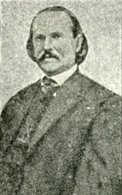| Eli Metcalfe Bruce | |
|---|---|

| |
| Representative to the Confederate Congress | |
In office 1862–1865 | |
| Preceded by | none |
| Succeeded by | none |
| Personal details | |
| Born | February 22, 1828 Fleming County, Kentucky |
| Died | December 15, 1866 (aged 38) New York City, New York |
| Spouse(s) | Elizabeth Sally Withers[1] |
| Profession | Entrepreneur |
Eli Metcalfe Bruce (February 22, 1828 – December 15, 1866) was a philanthropist and a Representative from Kentucky in the First and Second Confederate Congresses. He was the principle financier of the Confederate government of Kentucky during the Civil War.[2]
Early life[]
Eli Metcalfe Bruce was born near Flemingsburg, Kentucky, the son George S. and Sabina Metcalfe Bruce.[1] He was educated at the local schools until 1847 when he began working at a dry goods store in Maysville, Kentucky.[1] Shortly thereafter, he relocated to Northern Kentucky, where he worked at a pork packing factory owned by his uncle in Cincinnati, Ohio.[1]
In 1853, Bruce married Elizabeth Sally Withers, and the couple had three children.[1] The following year, he and his uncle opened an iron furnace business near Terre Haute, Indiana.[1] In 1859, he sold his interest in the iron furnace company and purchased several pork packing plants along the Mississippi, Missouri, and Wabash Rivers.[1] These entrepreneurial endeavors left Bruce a wealthy young man.[3]
Civil War[]
Near the outbreak of the Civil War, Bruce sold all of his enterprises in the north and moved to the south.[1] A Confederate sympathizer, Bruce attended a secession convention in Russellville, Kentucky, in November 1861, and was elected to the legislative council of the Commonwealth's Confederate shadow government.[4] When Kentucky was admitted to the Confederacy in December 1861, Bruce was elected to one of the Commonwealth's ten congressional seats.[1]
He personally financed many of the supply needs of Kentucky's Orphan Brigade.[1] His work in negotiating prisoner exchanges for this unit led to his being asked to negotiate such exchanges for the entire Confederate States Army.[1] Near the end of the war, Bruce and Jefferson Davis fled the Confederate capital at Richmond, Virginia.[1] He was later captured in Georgia, but with the end of the war, he was released and established an office in Augusta, Georgia, with the intent of helping Confederate soldiers return home.[1] On May 10, 1865, he published an open letter offering to pay the educational expenses of any Confederate soldier who had lost an arm or leg in the war.[1] All told, it was estimated that Bruce contributed $400,000 for the relief of Confederate soldiers.[1] He was pardoned of any wrongdoing with regards to his support of the Southern cause by President Andrew Johnson.[1]
Later life and death[]
Bruce financed the merger of two Louisville, Kentucky, newspapers – The Courier and The Journal – into The Courier-Journal.[5] He later moved to New York City, New York, where he became a cotton broker and opened a hotel for the use of former Confederate soldiers.[1] He continued to augment his fortune through wise investments, and shortly after the war, an abandoned South Carolina gold mine in which he had invested struck a new vein.[1]
Bruce died of heart disease on December 15, 1866, and was buried in Linden Grove Cemetery in Covington, Kentucky.[1] In 1917, his body was exhumed and reburied near his wife and daughter in Highland Cemetery[1] in Fort Mitchell, Kentucky.[6] The Northern Kentucky chapter of Sons of Confederate Veterans is named in his honor.[1]
See also[]
References[]
- ↑ 1.00 1.01 1.02 1.03 1.04 1.05 1.06 1.07 1.08 1.09 1.10 1.11 1.12 1.13 1.14 1.15 1.16 1.17 1.18 1.19 1.20 "Guide to the Bruce Family Papers". Northern Kentucky University. http://archives.nku.edu/special_collections/collections/bruce/finding_aid.php. Retrieved 2012-01-31.
- ↑ Cantrell, Doug (2005). "George W. Johnson and Richard Hawes: The Governors of Confederate Kentucky". Kentucky Through the Centuries: A Collection of Documents & Essays. Dubuque, Iowa: Kendall/Hunt Publishing Company. pp. 159–184. ISBN 0-7575-2012-X.
- ↑ "History of Elizaville". RootsWeb.com. http://www.rootsweb.com/~kyflemin/elizavillehistory.htm. Retrieved 2007-06-19.[dead link]
- ↑ "Wednesday, November 20, 1861". Civil War Landscapes Association. http://civilwarlandscapes.org/cwla/chr/calendar/1861/611120.htm. Retrieved 2007-06-19.
- ↑ Edwin Anderson Alderman, Southern Men of Letters, ed (2005). Library of Southern Literature Part 15. Kessinger Publishing. pp. 58. ISBN 1-4179-3319-4. http://books.google.com/books?id=RcmPQtF-mXcC.
- ↑ "Kentucky Historical Marker Database". Kentucky Historical Society. http://kentucky.gov/kyhs/hmdb/MarkerSearch.aspx?mode=County&county=59. Retrieved 2007-06-19.
External links[]
- Address by Eli Metcalfe Bruce to soldiers of the Orphan Brigade on May 10, 1865
- F. F. Lucas v. E. M. Bruce, et al. – 1864 court case in Louisville
The original article can be found at Eli Metcalfe Bruce and the edit history here.